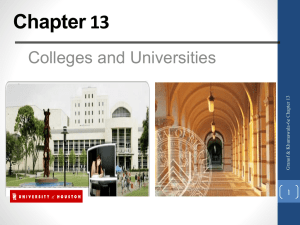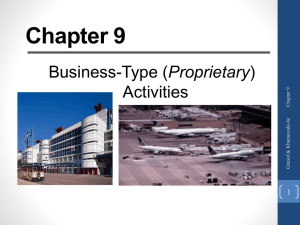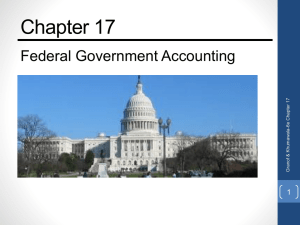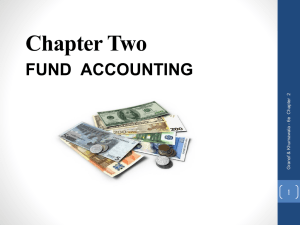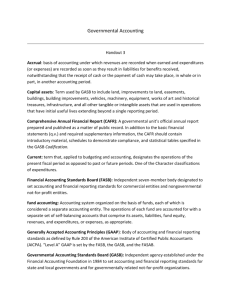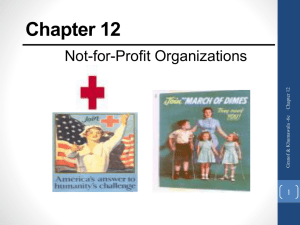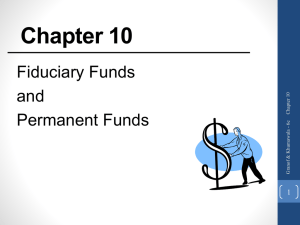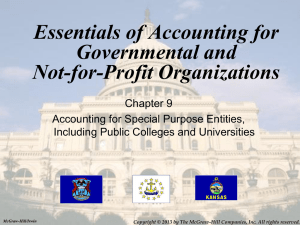primary government
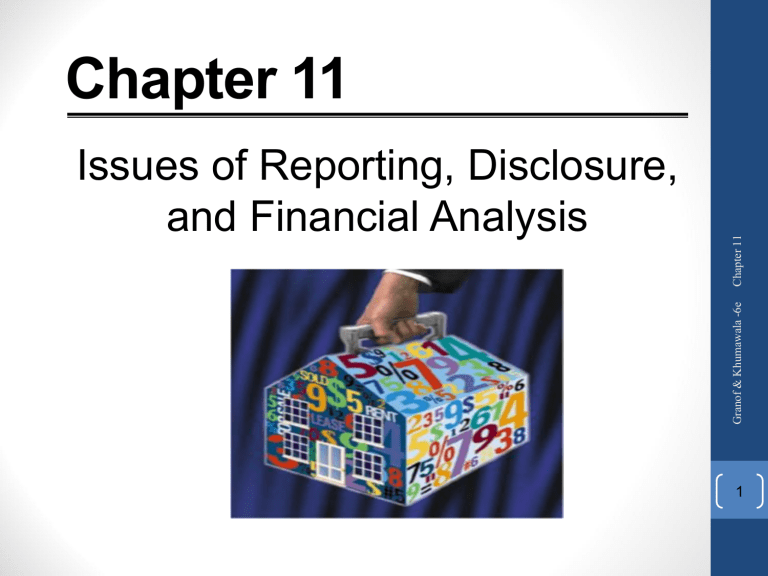
Chapter 11
Issues of Reporting, Disclosure, and Financial Analysis
1
Learning Objectives
• Conversion of Fund Statements to Government-wide
• Why the make-up of a government’s or not-for-profit’s reporting entity is an issue
• The criteria that the GASB has established to determine the units that constitute a government’s reporting entity
• Various ways of reporting component units
• Reports of special-purpose entities
• Elements of a government’s CAFR
• Critical factors to consider in assessing a government’s financial condition
2
Government Wide Statements
General Approach to preparing government-wide statements from fund statements:
• Start with a year-end trial balance that combines all of the governmental funds.
• Eliminate all inter-fund transactions.
• Adjust capital asset-related accounts
• Adjust long-term, debt-related accounts
• Adjust for differences in basis of accounting
• Consolidate the internal service fund
• Complete the government-wide trial balance
• Divide the accounts between Statement of Net Assets and Statement of Activities and then among the various functional accounts.
3
Reporting Entity
• Why is the reporting entity an issue?
-An organization’s legal entity differs from its economic entity.
• Composition of reporting entity
-- Primary government and its component units
Primary government: any state government, general purpose local governments (counties, cities, towns and villages), or a special purpose state or local government (school districts, hospital district)
• Special purpose government must:
-Have a separately elected governing body
-Be legally separate from other primary governments and be fiscally independent of other governments
-Have authority to determine its budget, levy taxes, and issue bonds.
4
Criteria for Reporting Entities
GAAP is GASB Statement No. 61, The Financial Reporting
Entity, Omnibus, an amendment of GASB Statements No.
14 and No. 34 (Nov 2010).
GASB Statement No.14, The Financial Reporting Entity and
GASB Statement No. 39, Determining Whether Certain
Organizations are Component Units.
Component units: are legally separate organizations for which the elected officials of the primary government are financially accountable.
Examples of common intergovernmental relationships in the US
Housing authorities established by cities to provide low cost financing for residents of the cities
Turnpike commissions
Volunteer fire departments
Universities that receive funding from the state but are controlled by Board of Regents
5
Flowchart for Evaluation and Presenting Component Units-GASB 61
Does the CU meet the criteria for blended presentation?
Does the CU meet the criteria for discrete presentation?
6
Criteria for Reporting Entities (Cont’d)
Component Units:
Reporting issue: Why?
and How?
- Exclusion of component unit might cause the primary government’s statements to be misleading.
• Example 1: State of New York established
Municipal Assistance Corporation to help the City of New York during financial difficulties.
• Example 2 : Houston Zoo, Greater Houston
Convention & Visitors Bureau
For reporting purposes, a governmental entity considers a component unit to be major based upon:
1) the type/kind of service provided by the CU and
2) its relationship with the PG
7
Criteria for Reporting Entities (Cont’d)
• Key criteria as to whether a primary government is financially accountable for another government thus qualifying the other government as a CU:
-The primary government appoints a voting majority of the unit’s governing body (or)
A majority of the unit’s governing body is composed of primary government officials.
• In addition, either one of the following criteria must be satisfied.
-The primary government is able to impose its will upon the potential component unit.
-The component unit is able to provide specific financial benefits to, or impose specific financial burdens on, the primary government.
8
Criteria for Reporting Entities (Cont’d)
• General Rule:
A component unit is fiscally accountable only if the primary government controls the appointment of its governing board.
• Exception: o If a component unit is fiscally dependent on the primary government, it is fiscally accountable even if its governing bodies are independently elected (not appointed by the primary government) and thereby outside the influence of the PG.
o Fiscal dependence: unable to set its own budget, levy taxes, set rates/charges, or issue bonds without the approval of the PG.
9
Reporting Component Units
• Discrete presentation: o
Default means of reporting.
o Reporting units in a single column, separate from the data of the primary government.
• Blending: o Transactions treated as part of the primary government.
o Appropriate when the primary government and the component unit are so closely related and are substantively the same.
10
Reporting Component Units (Cont’d)
• Major discretely presented component units for the City of
Houston include: o Cultural Arts Council of Houston o Greater Houston Convention and Visitor’s Bureau o Houston Downtown Park Corporation o Midtown Redevelopment Authority o Uptown Redevelopment Authority o Total Net Assets of all the discretely presented Governmental
Component units (major and nonmajor) for FY 2011 =
$151,034,000
• Discretely presented Business type Component units (major and nonmajor) for the City of Houston: o Houston Convention Center Hotel Corporation o Houston Housing Finance Corporation o Houston Zoo Inc.
o The total net assets for FY 2011 = $120,949,000
11
Required Disclosures
Primary government must disclose detailed information about each major component unit in either of the following:
• Government-wide statements (by presenting the component unit in a separate column)
• Notes to the financial statements
• Combining financial statements (one column for each major component unit)
12
Other Types of Units
• Joint Ventures: o A contractual agreement to carry out a common activity, with the participants sharing both risks and rewards.
o Ex: Dallas and Fort Worth joining together to construct and operate an airport.
• Related Organizations: defined by GASB Stmt. #14 as an entity to which/that o The City appoints board members but for which the City has no significant financial accountability.
o Does not qualify as a component unit o Cannot be incorporated into the primary government’s financial statements.
13
Other Types of Units (Cont’d)
• Affiliated Organizations: o Provide assistance (both financial and nonfinancial) to the associated government o The primary government does not appoint the governing boards o These organizations are not fiscally dependent on the primary government
• Examples: o A state university’s development foundation o A state university’s football booster club o A public school’s parent-teacher association
14
Other Types of Units (Cont’d)
GASB Stmt. # 39: Requires governments to report certain organizations as discretely presented component units if they are
• legally separate
• Tax exempt and meet all of the following conditions: o Economic resources held are for the direct benefit of the primary government or its component units.
o The primary government or its component units have direct access to the economic resources o The economic resources held or received are significant to that primary government.
15
Comprehensive Annual Financial Report
Popularly known as the CAFR and is divided into three sections:
• Introductory
• Financial
• Statistical
16
CAFR (Cont’d)
Introductory section:
• Table of contents
• Letter of transmittal
Most informative component of the CAFR and comprises of four main sections.
•
Formal transmittal of the CAFR
• Government profile
• Information on economic conditions
• Awards and acknowledgements
• Other important material deemed appropriate by management such as Government Finance Officers
Association’s Certificate of Achievement for Excellence in
Financial Reporting
17
CAFR (Cont’d)
Financial Section:
• Auditor’s report o Provides assurance about the fairness of the financial statements.
• Management’s Discussion and Analysis (MD&A) o Basic financial statements
Government-wide statements
Fund financial statements
• Required supplementary information: o Ex: Budget to actual comparisons o Details of pension actuarial valuations
• Combining statements, individual statements, and schedules o Supplement and support the basic statements o Provide details of the nonmajor funds
18
CAFR (Cont’d)
Statistical section:
• Supplements the financial statements
• Includes five categories of information o Financial trends o Revenue capacity o Debt capacity o Demographic and Economic statistics o Operating data
19
Special Purpose Governments
Reporting requirements:
• Must adhere to same reporting and disclosure requirements as general purpose governments.
• Must prepare both government-wide and fund statements if engaged in both business- and governmental-type activities.
• If engaged in only a single governmental program, government-wide and fund statements can be combined.
• If engaged only in business-type activities: o only the statements required for enterprise funds are needed o also include key elements of the financial section of
CAFR.
20
Requirements for Colleges and Universities
• GASB Stmt. # 34: Colleges and universities should be subject to same reporting requirements as specialpurpose entities engaging: o only in business-type activities o only in governmental activities o or in both
• Public colleges and universities follow GASB pronouncements
• Not-for-profit colleges and universities follow FASB pronouncements
This is discussed in depth in Chapter 13.
21
Government’s Fiscal Condition
• Assessing a government’s financial condition is a daunting task.
• CAFR is the single richest source of data in assessing the financial condition.
o Provides only a raw data of relationships and trends o Burden of analysis falls upon individual users
• A comprehensive analysis of assessing a city’s fiscal status is provided in Chapter 11, Table 11-4.
22
Fiscal Condition (Cont’d)
Factors affecting the fiscal condition:
• Demographic o Age, income distribution, educational level etc.
• Economic o Composition of taxpayers, industries in which they work etc.
• Political o Government structure, political competition, integrity of the officials, political climate etc.
• Social o Crime rates, percentage of residents owning homes etc.
• Other factors include: o Population o Enterprises o Technology
23
Budget and Financial Statements
• Budget: o detailed map of fiscal path o Analysts must evaluate the integrity of the budget.
o Reported on cash or near cash basis
• Financial Statements: o Reported on GAAP basis o Less likely to manipulate reported rather than budgeted revenues/expenses
24
Financial Indicators
• There are no reliable ‘rules of thumb.’
• Governments account for operations in different ways.
So, some ratios may not be directly comparable.
• Whether a lower or higher ratio is preferred is not always clear.
• Higher or lower ratio depends upon the stage of maturity.
• Ratios are no better than the underlying numbers.
25
Financial Indicators (Cont’d)
• Issue in interpreting financial indicators: o Should ratios be based on government-wide, general fund, or a combination of both?
o It depends on why the measure is being calculated and how it will be interpreted.
• Fiscal effort: o Extent to which a government is taking advantage of its fiscal capacity.
o Fiscal effort = Per capita revenue from own sources OR
Median family income
Revenue from own sources
Total appraised value of property
26
Financial Analysis
Goal of financial analysis:
• Evaluate the ability of a government to provide the services expected of it in the future.
• Preparing pro forma statements
• Identify key risks and uncertainties
• Examine a number of ‘what if’ situations
27
Summary
• Governments typically maintain their accounts on a fund basis. At year end they convert the accounts from a fund (modified accrual) basis to a government-wide (full accrual) basis.
• According to GASB, a primary government should include a potential component unit in it’s reporting entity if the unit is financially accountable to it.
• The Comprehensive Annual Financial Report (CAFR) has three sections: Introductory, Financial and Statistical.
• The Basic financial statements consist of the two governmentwide statements (the statement of net assets and statement of activities) and the fund statements for each of the three group of funds.
• Special-Purpose governments must prepare the same financial statements as general-purpose governments.
• In assessing a city’s fiscal condition, analysts should consider the current environment in which a government operates.
28
